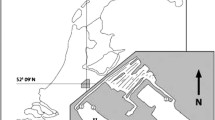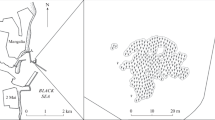Abstract
The seasonal dynamics of Bythonomus lemani (Lumbriculidae) were studied for the first time and the knowledge of Bothrioneurum vejdovskyanum (Tubificidae) was extended based on four quantitative samples of oligochaetes taken monthly in the Rokytná River (Czech Republic) during a two-year study (April 1999–April 2001). The influence of water temperature, velocity, depth, discharge, pH, conductivity, dissolved oxygen amount and biochemical oxygen demand (BOD) on their life cycles was evaluated. Habitat preferences of the juvenile and adult stages were recorded. Time series analysis was used to determine the worm densities, seasonality and trends. For Byth. lemani one distinct reproduction cycle per year was found and this was regulated by temperature, while Both. vejdovskyanum showed a one-year cycle not significantly dependent on measured environmental variables. The overall trend was an increase in density for Byth. lemani and a decrease in density for Both. vejdovskyanum. Byth. lemani showed a significant negative correlation between the trend of its density and BOD concentration.
Similar content being viewed by others
References
Adreani, L., Bonacina, C., Bonomi, G. & Monti, C. 1984. Cohort cultures of Psammoryctides barbatus (Grube) and Spirosperma ferox Eisen: a tool for a better understanding of demographic strategies in Tubificidae. Hydrobiologia 115: 113–119.
Bonomi, G. 1979. Ponderal production of Tubifex tubifex Müller and Limnodrilus hoffmeisteri Claparède (Oligochaeta, Tubificidae), benthic cohabitants of an artifical lake. Boll. Zool. 46: 153–161.
Bonomi, G. 1980. Population dynamics of Tubifex tubifex, studied by means of a new model, pp. 185–203. In: Brinkhurst, R.O. & Cook D.G. (eds) Aquatic oligochaete biology. Plenum Publishing Corporation, New York.
Box, G.E.P. & Jenkins, G.M. 1970. Time series analysis. Forecasting and Control. Holden Day, San Francisco, 553 pp.
Brinkhurst, R.O. 1966. The Tubificidae (Oligochaeta) of polluted waters. Verh. Int. Verein. Limnol. 16: 854–859.
Brinkhurst, R.O. 1978. Oligochaeta, pp. 139–144. In: Illies, J. (ed.) Limnofauna Europaea, Gustav Fischer Verlag, New York.
Brinkhurst, R.O. & Jamieson, B.G.M. 1971. Aquatic Oligochaeta of the World. Oliver & Boyd, Edinburgh, 860 pp.
Brinkhurst, R.O. & Kennedy, C.R. 1965. Studies on the biology of the Tubificidae (Annelida, Oligochaeta) in a polluted stream. J. Anim. Ecol. 34: 429–443.
ČSN 75 7358 1997. Jakost vod — Klasifikace jakosti povrchových vod [Water quality — Classification of surface water ]. Czech Standards Institute, Praha, 9 pp.
Daniels, H.E. 1950. Rank correlation and population models. J. Roy. Stat. Soc. B 12: 171–181.
Dumnicka, E. 1982. Stream ecosystems in mountain grassland (West Carpathians), 9. Oligochaeta. Acta Hydrobiol. 24: 391–398.
Dumnicka, E. & Kukuła, K. 1990. The communities of oligochaetes of the Wołosatka and Terebowiec streams (the Bieszczady National Park, Southeastern Poland). Acta Hydrobiol. 30: 423–435.
Helan, J., Kubíček, F., Losos, B., Sedlák, E. & Zelinka, M. 1973. Production conditions in the trout brooks of the Beskydy Mountains. Folia Fac. Sci. Nat. Univ. Purk. Brun. Biol. 38: 1–105.
Hrabé, S. 1935a. O nepohlavním rozmnožování nítěnky Bothrioneurum vejdovskyanum Štolc [About the asexual reproduction of Bothrioneurum vejdovskyanum Štolc]. Sbor. Kl. Přír. Brno 17: 13–18.
Hrabě, S. 1935b. Über Moraviodrilus pygmaeus n. g. n. sp., Rhyacodrilus falciformis Br., Ilyodrilus bavaricus Oschm. und Bothrioneurum vejdovskyanum. Št. Spisy Přír. Fak. Univ. Brno 209: 1–19.
Hrabě, S. (ed.) 1954. Klíč k určování zvířeny ČSR [Key to the Czechoslovak fauna]. Vol. 1, ČSAV, Praha, 540 pp.
Hrabě, S. 1981. Vodní máloštětinatci (Oligochaeta) Československa [Aquatic Oligochaeta of Czechoslovakia]. Acta Univ. Carol. Biol. 1979: 1–168.
Kennedy, C.R. 1966. The life history of Limnodrilus hoffmeisteri Clap. (Oligochaeta: Tbificidae) and its adaptive significance. Oikos 17: 158–168.
Ladle, M. 1971. The biology of Oligochaeta from Dorset chalk streams. Freshwater Biol. 1: 83–97.
Lazim, M.N. & Learner, M.A. 1986. The life-cycle and production of Limnodrilus hoffmeisteri and L. udekemianus (Tubifidae; Oligochaeta) in the organically enriched Moan-Feeder Stream, Cardiff, South Wales. Arch. Hydrobiol. 74: 200–225.
Lazim, M.N., Learner, M.A. & Cooper, S. 1989. The importance of worm identity and life history in determining the vertical distribution of tubificids (Oligochaeta) in a riverine mud. Hydrobiologia 178: 81–92.
Learner, M.A., Lochhead, G. & Hughes, B.D. 1978. A review of the biology of British Naididae (Oligochaeta) with emphasis on the lotic environment. Freshwater Biol. 8: 357–375.
Petto, H. & Humpesch, U.H. 1992. Time series analysis of developmental cycles of oligochaetes in relation to environmental factors in the River Danube. Arch. Hydrobiol. 124: 53–67.
Pfannkuche, O. 1981. Distribution, abundance and life cycles of aquatic Oligochaeta (Annelida) in a freshwater tidal flat of the Elbe Estuary. Arch. Hydrobiol., Suppl. 43: 506–524.
Poddubnaya, T.L. 1968. Biologiya rozmnozhenia vida Chaetogaster diaphonus [Biology of reproduction of Chaetogaster diaphanus]. Trudy Inst. Biol. Vnutr. Vod Akad. Nauk SSSR 17: 3–20
Risnoveanu, G. & Vadineanu, A. 2002. Observations on the population dynamics of Potamothrix hammoniensis (Michaelsen, 1901) (Tubificidae, Oligochaeta) in Lake Isacova in the Danube Delta. Hydrobiologia 479: 23–30.
Rodriguez, P. 1988. Sur certaines espèces de Lumbriculidae (Annelida: Oligochata) du nord de la péninsule ibérique. Ann. Limnol. 24: 203–211.
Rodriguez, P. & Armas, J.C. 1983. Contribution à la connaissance de la faune d’Oligochètes aquatiques du pays basque et zones limitrophes. Ann. Limnol. 19: 93–100.
StatSoft, Inc. 2004. STATISTICA (data analysis software system), version 7. www.statsoft.com, 1984–2005.
Thorhauge, F. 1976. Growth and life cycle of Potamothrix hammoniensis (Tubificidae, Oligochaeta) in the profundal of eutrophic Lake Esrom. A field and laboratory study. Arch. Hydrobiol. 78: 71–85.
Timm, T. 1984. Potencial age of aquatic Oligochaeta. Hydrobiologia 115: 101–104.
Uzunov, V., Košel, V. & Sládeček, V. 1988. Indicator value of freshwater Oligochaeta. Acta Hydrochim. Hydrobiol. 16: 173–186.
Author information
Authors and Affiliations
Rights and permissions
About this article
Cite this article
Schenková, J., Helešic, J. & Jarkovský, J. Seasonal dynamics of Bythonomus lemani and Bothrioneurum vejdovskyanum (Oligochaeta, Annelida) in relation to environmental variables. Biologia 61, 517–523 (2006). https://doi.org/10.2478/s11756-006-0085-x
Received:
Accepted:
Issue Date:
DOI: https://doi.org/10.2478/s11756-006-0085-x




